Water bath baking ensures a moist, evenly cooked cheesecake by gently regulating the temperature, preventing cracks and a dense texture. Dry baking, while faster, often results in a firmer crust but can cause uneven cooking and a drier, crumbly consistency. Choosing between water bath and dry bake depends on the desired cheesecake texture and appearance.
Table of Comparison
| Method | Water Bath | Dry Bake |
|---|---|---|
| Moisture Level | High moisture, smooth texture | Lower moisture, denser texture |
| Temperature Control | Even, gentle heat via steam | Direct dry oven heat |
| Cracking Risk | Minimal cracking | Higher cracking risk |
| Baking Time | Longer due to steam | Shorter, more intense baking |
| Ease of Setup | Requires water bath preparation | Simple, no extra setup |
| Resulting Creaminess | Ultra creamy, silky finish | Firm and rich |
Understanding Water Bath and Dry Bake Methods
Water bath baking for cheesecake involves placing the cake pan in a larger pan filled with hot water, creating gentle and even heat that prevents cracking and results in a creamy texture. Dry baking uses only the oven's direct heat, which can cause the surface to brown more and the texture to be denser but quicker to set. Understanding these methods helps bakers choose between a smooth, custard-like cheesecake or a firmer, more traditional style.
Key Differences Between Water Bath and Dry Bake
Water bath baking ensures even heat distribution and prevents cracking by surrounding the cheesecake with moisture, resulting in a smooth, creamy texture. Dry baking exposes the cheesecake directly to hot air, which can lead to uneven cooking and a firmer, sometimes cracked surface. The key difference lies in moisture control, where water bath maintains humidity, while dry baking creates a drier environment affecting the cake's consistency and appearance.
Pros and Cons of Using a Water Bath for Cheesecake
Using a water bath for cheesecake provides even heat distribution, reducing the risk of cracking and ensuring a smooth, creamy texture. However, it requires careful setup to prevent water from seeping into the batter and can increase baking time due to the moisture environment. Dry baking, while simpler and faster, often results in a denser cheesecake with a higher chance of cracks and uneven cooking.
Pros and Cons of Dry Baking Cheesecake
Dry baking cheesecake produces a firmer texture and a more defined crust, making it ideal for traditional New York-style cheesecakes. This method prevents water from seeping into the batter, reducing the risk of a soggy bottom, but it can cause the cheesecake to crack due to uneven heat distribution. Dry baking requires careful temperature control and monitoring to avoid overcooking and achieving a dense, less creamy consistency compared to water bath baking.
How Water Baths Prevent Cracks and Overbaking
Water baths create gentle, even heat around the cheesecake, preventing cracks by maintaining consistent moisture and temperature during baking. This method reduces the risk of overbaking by insulating the batter and allowing gradual setting. In contrast, dry baking exposes the cheesecake to direct oven heat, often causing uneven cooking and surface cracks.
Texture and Flavor: Water Bath vs Dry Bake Cheesecake
Water bath baking ensures a smooth, creamy texture in cheesecake by providing gentle, even heat that prevents cracking and overcooking. Dry bake methods often create a denser, richer cheesecake with a slightly firmer edge and intensified caramelized flavor. Choosing water bath results in a delicate, melt-in-your-mouth consistency, while dry baking enhances depth of flavor and a chewy, custard-like bite.
Essential Tools and Equipment for Each Baking Method
Water bath baking requires a deep roasting pan filled with hot water to create steam, along with a springform pan wrapped in foil to prevent water seepage. Dry baking necessitates a heavy-duty springform pan and often an oven thermometer to monitor precise temperature control, ensuring even heat distribution. Both methods benefit from a sturdy cooling rack to allow the cheesecake to cool gradually and maintain its texture.
Step-by-Step Guide: Water Bath Cheesecake Technique
Water bath cheesecake technique involves placing the filled springform pan into a larger pan filled with hot water to ensure gentle, even baking and prevent cracking. Start by wrapping the bottom of the pan with aluminum foil to stop water seepage, then bake the cheesecake at a low temperature, typically between 325degF and 350degF, for about 50-70 minutes until the edges are set but the center is slightly jiggly. This method produces a smooth, creamy texture by maintaining consistent moisture and temperature throughout the baking process.
Step-by-Step Guide: Dry Bake Cheesecake Technique
Dry bake cheesecake technique involves mixing the batter thoroughly and pouring it into a greased springform pan before baking at a steady temperature of 325degF (163degC) for about 50-60 minutes until the edges are set and the center is slightly jiggly. After baking, let the cheesecake cool gradually in the oven with the door ajar to prevent cracking, then chill it in the refrigerator for at least 4 hours or overnight to achieve a smooth, dense texture. This method eliminates the need for a water bath, reducing preparation time but requiring careful temperature control to maintain moisture and prevent overbaking.
Expert Tips for Choosing the Right Baking Method
Water bath baking ensures even heat distribution and prevents cracks on cheesecake surfaces by maintaining consistent moisture during baking, ideal for delicate, creamy textures. Dry baking offers a quicker, more straightforward method but risks dry edges and uneven cooking, best suited for denser, firmer cheesecakes. Experts recommend using a water bath for classic New York-style cheesecake while opting for dry baking when time constraints outweigh texture precision.
Water bath vs Dry bake for cheesecake Infographic

 cookingdif.com
cookingdif.com